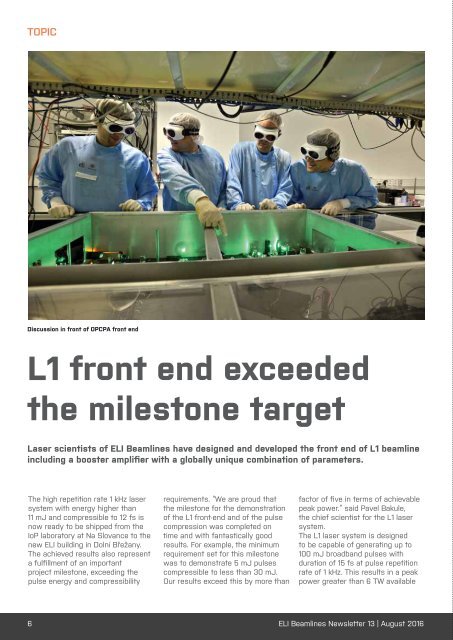No.13
Newsletter-13
Newsletter-13
Create successful ePaper yourself
Turn your PDF publications into a flip-book with our unique Google optimized e-Paper software.
TOPIC<br />
on a target every millisecond.<br />
The whole system will be installed<br />
in the new laser hall in Dolní Břežany<br />
by end of 2017 by the laser team led<br />
by Pavel Bakule.<br />
Discussion in front of OPCPA front end<br />
L1 front end exceeded<br />
the milestone target<br />
The completed front end<br />
system uses state-of-the-art<br />
laser technology, which exploits<br />
exceptionally good beam quality<br />
generated by thin disk based pump<br />
lasers to pump multiple stages<br />
of optical parametric amplifiers<br />
(OPCPA). The front end laser is<br />
specifically designed to generate<br />
high quality, high temporal contrast<br />
broadband signal laser pulses, that<br />
are then further amplified to high<br />
energy in the main amplification<br />
chain based on picosecond pumped<br />
OPCPA. In a parametric process,<br />
there is no pumped energy stored<br />
in the nonlinear crystals and there<br />
is no gain outside the picosecond<br />
pump window, allowing for high<br />
contrast of the signal (a ratio<br />
between the main laser pulse with<br />
respect to parasitic prepulses and<br />
postpulses). In addition, the front<br />
end plays an important role in<br />
terms of achievable beam quality<br />
and stability at the final laser<br />
output. “Since a high power, high<br />
repetition rate beam is very difficult<br />
to handle, all minor tweaking,<br />
beam conditioning and dispersion<br />
management must take place in the<br />
front end,” said František Batysta,<br />
junior researcher at L1.<br />
Laser scientists of ELI Beamlines have designed and developed the front end of L1 beamline<br />
including a booster amplifier with a globally unique combination of parameters.<br />
The high repetition rate 1 kHz laser<br />
system with energy higher than<br />
11 mJ and compressible to 12 fs is<br />
now ready to be shipped from the<br />
IoP laboratory at Na Slovance to the<br />
new ELI building in Dolní Břežany.<br />
The achieved results also represent<br />
a fulfillment of an important<br />
project milestone, exceeding the<br />
pulse energy and compressibility<br />
requirements. “We are proud that<br />
the milestone for the demonstration<br />
of the L1 front-end and of the pulse<br />
compression was completed on<br />
time and with fantastically good<br />
results. For example, the minimum<br />
requirement set for this milestone<br />
was to demonstrate 5 mJ pulses<br />
compressible to less than 30 mJ.<br />
Our results exceed this by more than<br />
factor of five in terms of achievable<br />
peak power.” said Pavel Bakule,<br />
the chief scientist for the L1 laser<br />
system.<br />
The L1 laser system is designed<br />
to be capable of generating up to<br />
100 mJ broadband pulses with<br />
duration of 15 fs at pulse repetition<br />
rate of 1 kHz. This results in a peak<br />
power greater than 6 TW available<br />
One thing that laser scientists<br />
always try to keep in mind when<br />
designing such a complex laser<br />
system, is that the users are<br />
expecting the beam to be available<br />
daily and for extended periods of<br />
time. A lot of effort is therefore put<br />
into high quality customised designs<br />
aimed at making all subsystems<br />
reliable and automated where<br />
possible. “We can’t be spending time<br />
fiddling with mirrors and playing<br />
with laser alignment; we focus on<br />
engineering the laser subsystems<br />
that we can set and forget wherever<br />
possible”, said Jonathan Green, the<br />
senior researcher at L1. One example<br />
of this is the fiber-based seed<br />
The third stage of OPCPA<br />
distribution system. “We have<br />
a network of fiber components<br />
which condition and distribute the<br />
seed pulses from a single oscillator<br />
to all our pump lasers and require<br />
no alignment whatsoever! Just<br />
two boxes, which fit nicely in an<br />
electronics rack, replace a 5 way<br />
optical splitter, 2 Offner stretchers,<br />
4 pulse pickers, 2 delay lines, and<br />
2 piezo actuated mirrors. Having all<br />
this taken care of in a box with just<br />
an ON switch makes our life a lot<br />
easier in the lab,” Green said.<br />
All L1 beamline pump lasers, used<br />
for pumping the optical parametric<br />
amplifiers, are based on Yb:YAG<br />
thin disk technology. In industry,<br />
continuous thin disk lasers are<br />
known for their exceptional quality<br />
and reliability. In the L1 front end<br />
two high repetition rate, high<br />
energy picosecond thin disk pump<br />
6 ELI Beamlines Newsletter 13 | August 2016 7


